Animals come in all shapes, colors, and sizes.
There are two ways color is created in nature:
- using pigments
- using structures that refract light to produce different hues
Pigments are chemical compounds that give animals their color – brown animals contain a lot of melanin in their fur/feathers.
According to research published in the National Academy of Science, animals synthesize two chemically distinct types of melanin: eumelanin (black to dark brown in color) and phaeomelanin (rufous, brown, and buff in color).
In other animals, colors are produced as the light gets refracted by the proteins found in the feathers/fur.
Brown color in animals can communicate several things:
- It can serve as a breeding signal
- It can serve as a warning signal
- It can help camouflage the animal
- It can help adapt better to the environment
Examples of brown animals include camels, brown bears, alpacas, orangutans, bush pigs, capybaras, marmots, minks, brown trouts, golden eagles, and many others.
Here are 25 of the most interesting ones and their photos.
Table of Contents
25 Brown Animals
Bactrian Camel
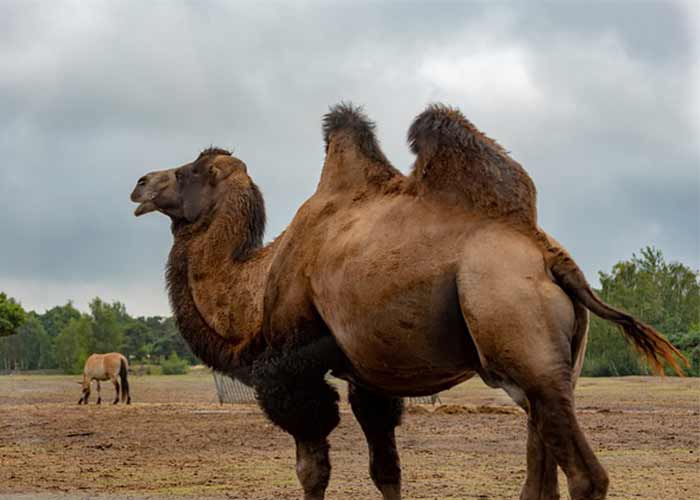
- Scientific Name: Camelus bactrianus
- Size: 7.5-8.2 ft
- Weight: 660-2,200 lb
Bactrian camels are large animals found in the steppes of Central Asia.
They are also known as Mongolian camels or domestic Bactrian camels, although there is also another, wild Bactrian species in existence today.
In contrast to their cousins, dromedary camels, Bactrian ones have two instead of one hump.
They are one of the largest mammals in Asia and can weigh up to 2,200 pounds and reach a height of up to 8.2 feet.
Bactrian camels have long and woolly coats that range from dark brown to sandy beige color.
They live in very extreme environments, where temperatures range from as low as −22 °F in winter to 122 °F in summer, and their brown fur color helps them withstand such temperatures.
These brown animals can go for weeks without water, thanks to their humps that are made of fat (not water), and many other adaptations.
If there’s not enough food available, their humps will drop to one side; when well fed, the humps are plump and erect.
Bactrian camels are active during the day and mostly feed on plants (occasionally meat, if no other food is available).
They have tough mouths that allow them to even chew the plants with large thorns and will even eat snow to satisfy the need for water.
It is thought that Bactrian camels got domesticated in China and Mongolia, some 5,000–6,000 years ago, and people have been using them as beasts of burden ever since to transfer goods on the Silk Road.
Brown Bear
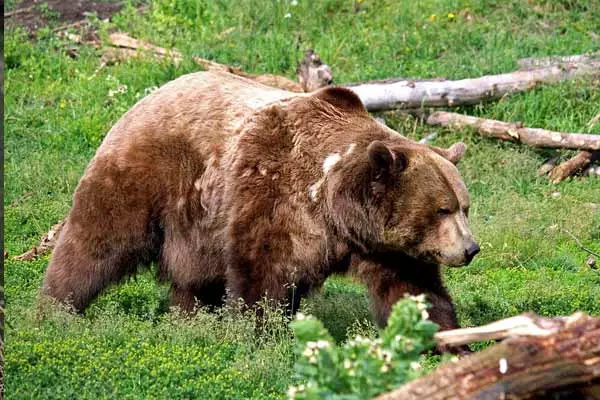
- Scientific Name: Ursus arctos
- Size: 2.3-5 ft
- Weight: 180-1,300 lb
National animals of several countries, brown bears are large bear species found in Europe, Asia, and North America.
In North America, people know brown bears as North American brown bears or simply grizzly bears; there is another subspecies of brown bears inhabiting the Kodiak Islands of Alaska known as Kodiak bears.
They are one of the largest bear species in the world, slightly smaller than polar bears.
Brown bears measure from 4 ft 7 inches to 9 ft 2 inches in length and weigh from 180 to 1,300 pounds.
Despite having such massive weight, they can still reach a top speed of 30 mph.
Brown bears, as the name suggests, have long and thick, usually brown fur, depending on the location.
They have an excellent sense of smell and can locate food that is several miles away.
If you have ever seen trees with claw marks, that’s how bears mark their territory, by scratching and rubbing on the bark.
Brown bears will hibernate during winter for several months to survive the harsh environment with very little food.
Their cubs are born blind and naked and have the size of a small chipmunk.
Bears are related to many different animals, including seals, skunks, raccoons, weasels, domestic dogs, wolves, and foxes among others.
And you might be surprised to learn that people say that bears mostly smell surprisingly clean and fresh.
Alpaca
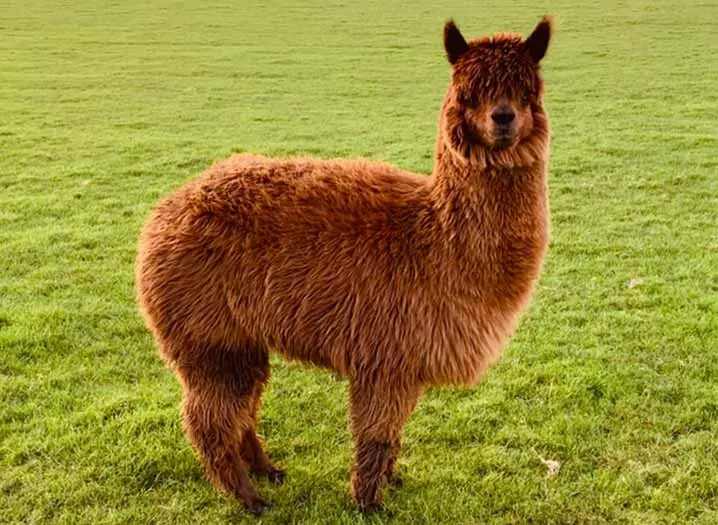
- Scientific Name: Lama pacos
- Size: 2.7-3.2 ft
- Weight: 110-190 lb
Alpacas are South American camelids that are often confused with llamas.
Both species are closely related to camels and are thought to be domesticated by the Andean people from vicunas and guanacos.
Alpacas are herbivores and very social animals; people keep them for their personality and soft coarse wool.
These animals come in different colors: the Alpaca Owners Association (AOA) recognizes sixteen primary alpaca colors that include dark fawn, light brown, medium brown, dark brown, white, beige, light fawn, medium fawn, black, gray, etc.
Recognize these cute animals by their small heads, shorty pointy ears, short snouts, and very long necks. Occasionally, males will have head hair overgrow and cover their eyes.
Alpacas can be found in Peru, Bolivia, and Chile, at elevations going from 9,840 up to 15,750 ft. They live in humid places of the Andean high plateaus where tender grass can grow.
The natives of South America have been using alpacas for their fine wool, hide, meat, and dung; Incas were selectively breeding the animals for their soft fiber and fine textiles.
Today, people raise alpacas to sell their wool, but also for their meat – some say that alpaca meat is tastier than the meat of a llama.
Because of their cute looks, and docile and gregarious personalities, many people keep them as pets or show animals on their farms or at zoos.
Peru holds a national Alpaca Day every 1st of August in honor of its most lucrative animal.
Alpaca wool is one of their most commercialized aspects.
Their fine and soft fiber is preferred by the textile industry and artisan producers. Alpaca fiber measures from 20 to 35 microns and is said to be 7 times warmer than sheep wool.
Orangutan
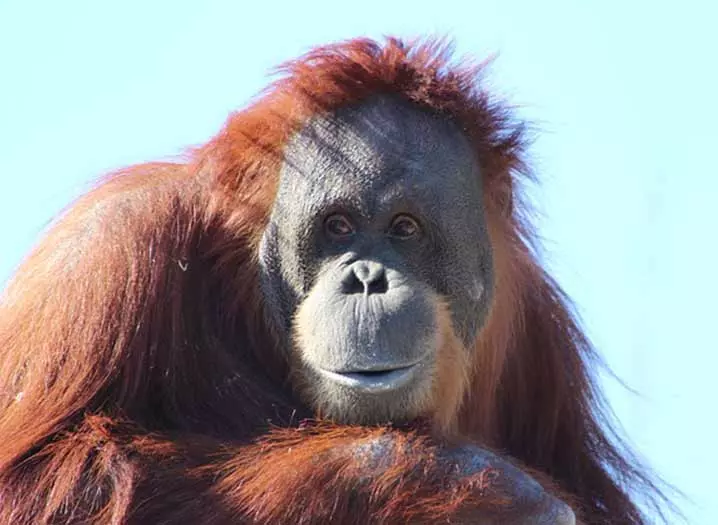
- Scientific Name: Pongo
- Size: 4 ft 6 in
- Weight: 165 lb
Orangutans are great apes that are found in the rainforests of Indonesia and Malaysia.
The heaviest of the tree-dwelling animals, orangutans have exceptionally long arms, short legs, and reddish-brown color of their bodies.
They also have admirable foreheads, especially noticeable in younger apes.
Males can develop thick cheekpads that make their heads stand out.
After they develop their fatty face cheeks, orangutans will become very aggressive towards other males that come close to them or their females.
They are also our closest relatives – we share almost 97% of the same DNA with them.
The word orangutan comes from the Malay words “orang” and “hutan“, meaning “human of the forest“.
There are 3 species of orangutans: the Bornean orangutan (P. pygmaeus), the Sumatran orangutan (P. abelii), and Tapanuli orangutan (P. tapanuliensis) – all of them are considered critically endangered.
Due to poaching, habitat loss, deforestation, and the illegal pet trade, their populations have severely declined.
Bush Pig
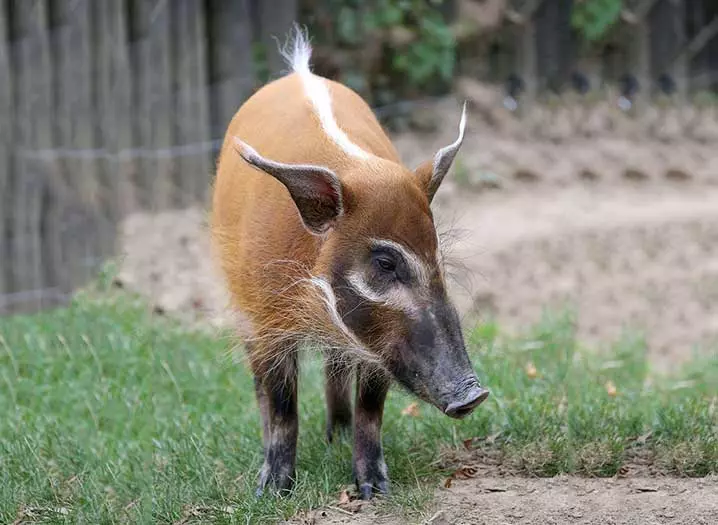
- Scientific Name: Potamochoerus larvatus
- Size: 26-39 in
- Weight: 130-180 lb
Bushpig or bush pig is a wild pig that lives in the forests and savannas of Africa and Madagascar.
It is easy to recognize by the big and muscular snout, short legs, small eyes, and pointy white-tufted ears.
Depending on the region they live in, bushpigs can be reddish-brown to dark-brown; their coat color darkens with age.
Young bushpigs are dark brown colored and have pale longitudinal stripes to camouflage and help blend in dense vegetation.
Bushpigs belong to the family of pigs and can be rarely seen in the wild because they live in hard-to-access terrains and are active mostly during the night.
A female bushpig that has reproduced is called a sow, while a female that has not reproduced is called a gilt.
They are excellent swimmers and to cool down, they will often cover themselves in mud – a trait shared by lots of animals.
Bushpigs have groups called sounders that consist of 4-10 animals and include the alpha male, alpha female, and their young.
Bongo Antelope
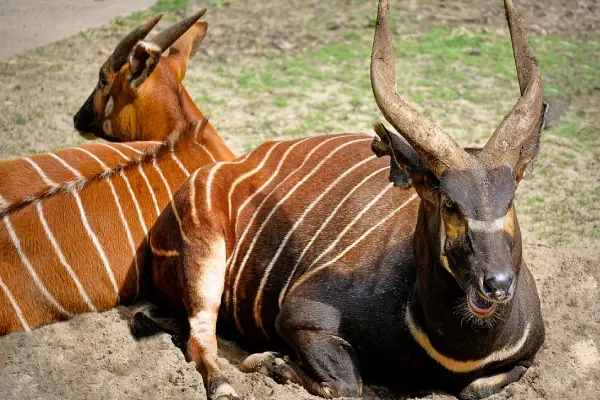
- Scientific Name: Tragelaphus eurycerus
- Size: 7.1-10.3 ft
- Weight: 330-520 lb
Bongos are one of the largest forest antelopes and the third-largest antelope species in the world.
These herbivorous and nocturnal ungulates (mammals with hooves) are easy to recognize by the deep brown color of their coats with bright white stripes on their sides to help camouflage better.
Both sexes have spiraled horns and very long tails (18-26 in).
These African natives have two subspecies: the western or lowland bongo, (T. e. eurycerus) and the eastern or mountain bongo (T. e. isaaci).
Eastern bongos have darker brown colors than western bongos. The pigmentation in their coats rubs off easily and some anecdotal reports claim that rain running off a bongo will be brown-reddish.
Thanks to the superstition saying that if you eat or touch a bongo, you will have an epileptic seizure, they aren’t hunted too much in their native range.
Often found in small groups or alone, these brown antelopes are browsers and eat leaves, twigs, flowers, and thistles. They will also eat wood burned by the lightning storm to get salt and minerals.
To walk through dense forests, bongos need to tilt their heads up and rest horns flat on their backs. Because of this frequent head movement, older bongos will have bald spots on their backs from horns rubbing away the fur.
Marmot
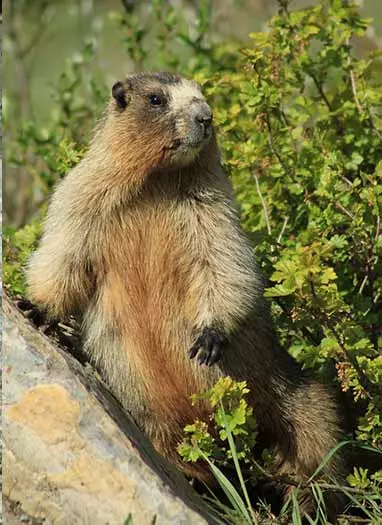
- Scientific Name: Marmota
- Size: 17-28 in
- Weight: 6-15 lb
Marmots are a large group of rodents that consists of 15 species (including groundhogs) living in Asia, Europe, and North America.
All of them have short legs, big claws they dig the ground with, heavy bodies, and large heads.
Marmots can have various shades of brown and gray with streaks of white, black, reddish-brown, or yellow.
Their fur color is produced by two pigments: yellow pheomelanin and black eumelanin, making their fur color vary from white to dark brown.
One species of marmots, the Vancouver Island marmots found in Vancouver Island, British Columbia, Canada, are uniformly dark brown.
Marmots hibernate 7-8 months per year and can lose two-thirds of their body weight during that period.
They will use hind-leg lookouts to watch for predators while the other members of the group eat. When they spot a predator, marmots will whistle loudly to warn the others.
Capybara

- Scientific Name: Hydrochoerus hydrochaeris
- Size: 3.5-4.4 ft
- Weight: 77-150 lb
Capybaras are the largest living rodents native to South America.
Often found around savannas, dense forests, and near bodies of water, these highly social animals can be seen in groups as large as 100 individuals.
Much like groundhogs and marmots, they can use their long front teeth to chew plants and grasses and eat things like melons, fruits, and seeded plants.
Although they might look similar to woodchucks, capybaras do not have tails and weigh significantly more than them.
Capybaras can be recognized by their heavy, barrel-shaped bodies, short heads, and reddish-brown fur on the upper part of their bodies.
Their two long front teeth never stop growing and to keep them at a reasonable length, capybaras will grind and chew on tough food and tree bark.
Mink
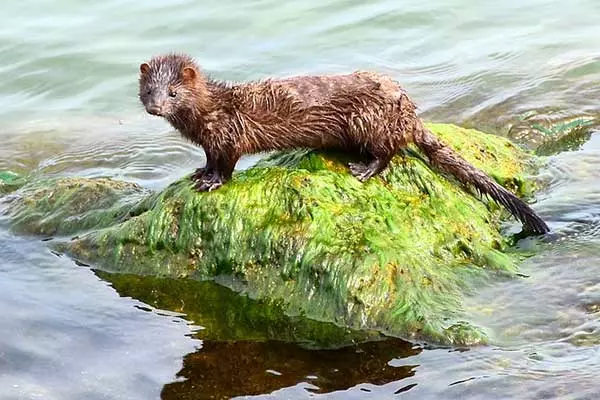
- Scientific Name: Mustela or Neovison
- Size: 13-18 in
- Weight: 1.1-3.5 lb
Minks are small semiaquatic mammals found in North America, Europe, and Asia.
These animals are often found near lakes and rivers when there’s a tree cover nearby.
They have elongated and thin bodies, short legs, pointed snouts, and sharp claws – in the wild, minks’ color ranges from tawny brown to a deep dark brown.
Minks are excellent diggers, swimmers, and climbers – they can swim up to 100 feet underwater and jump from tree to tree.
When they are happy, minks will purr.
Despite looking cute, they are excellent predators that kill their prey with a bite to the neck.
Minks feed on muskrats, rabbits, mice, chipmunks, fish, snakes, frogs, and birds.
Because they resemble prairie dogs, some people might confuse them for rodents, but minks belong to the weasel family of animals.
There are 2 species of minks today: the American and the European mink.
Brown Trout
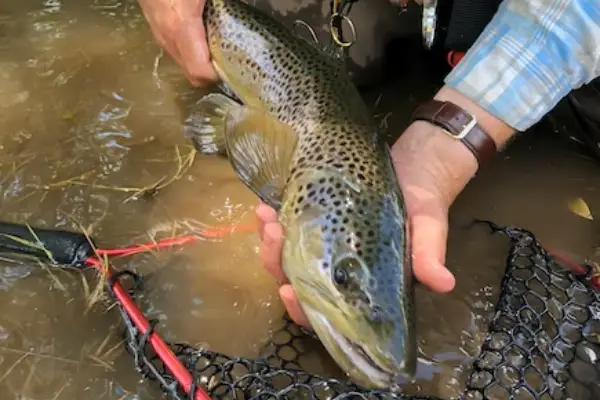
- Scientific Name: Salmo trutta
- Size: 14-24 in
- Weight: 2-10 lb
Also known as brownies or German trouts, brown trouts are brown fish native to western Europe.
Today, they are found on every continent except Antarctica. In the USA, they are widely distributed and can be found throughout 45 states.
Brown trouts have slender, green to reddish-brown bodies and long narrow heads.
These medium-sized fish can grow up to 44 pounds but usually weigh from 2 to 10 lbs.
The heaviest brownie in the USA weighed 41 pounds 7 ounces and was caught in Michigan in 2010.
Brown trouts inhabit lakes and rivers and can live from 12 to 20 years.
They are carnivores and feed on insects, salamanders, frogs, worms, and other fish.
Golden Eagle

- Scientific Name: Aquila chrysaetos
- Wingspan: 70.8-90.1 in
- Weight: 9-14 lb
Golden eagles are one of North America’s largest eagle species.
These enormous birds are one of the fastest and most agile birds of prey in the USA.
Identify golden eagles by their overall dark brown plumage and the lighter golden-brown color of their napes.
Their agility and speed together with powerful feet and large, sharp talons allow golden eagles to hunt rabbits, hares, and ground squirrels.
Golden eagles will catch rising masses of warm air to soar in the air with very little effort and look for their next meal – when they spot their prey, these brown-colored eagles will swoop at 200 mph.
Golden eagles are monogamous and mate for life. They are very territorial and will often attack hawks, eagles, and falcons that enter their territory.
They construct huge nests that can be 5-6 feet wide and 2 feet high – the largest ever recorded golden eagle nest was 20 feet tall and 8.5 feet wide!
Read More: Examples of eagles that live in Japan
Walrus

- Scientific Name: Odobenus rosmarus
- Size: 12 ft
- Weight: 2,200-4,400 lb
Walruses are large marine mammals that live in freezing waters near the Arctic Circle.
They are gregarious and sometimes live in groups of up to 100 animals.
These large flippered marine mammals are hard to miss due to their prominent tusks and whiskers; walruses usually have a dark brown or reddish-brown color.
Walruses are almost two times heavier than bears, but that doesn’t stop bears from occasionally attacking them.
There are 2 walrus species: the Pacific walrus and the Atlantic walrus.
Pacific walruses are spread from Russia to the US (Alaska), ranging from the Bering to the Chukchi Seas, as well as the Laptev Sea. Atlantic walruses inhabit the ice-covered northern waters of Canada, Greenland, Norway, and Russia.
Females are very protective of their young and will pick them up with their flippers and hold them in their chests as they dive into the water to escape danger.
Walruses are carnivores and consume worms, snails, crabs, shrimp, clams, and mollusks.
Walruses are just of many animals similar to sea lions – check the full list here.
Pangolin
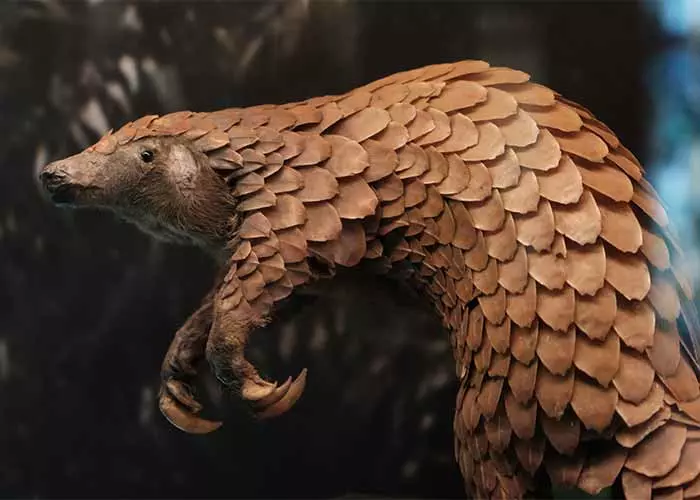
- Scientific Name: Pholidota
- Size: 12-39 in
- Weight: 4.4-7 lb
Pangolins are sometimes called scaly anteaters, and no wonder why; they have elongated snouts and tongues they use to eat their favorite food, ants and termites.
One could easily say that pangolins look like anteaters covered in tough armored scales.
However, despite their similar looks, pangolins and anteaters are not that closely related animals as anteaters belong to the order Pilosa while pangolins belong to the Pholidota animal order.
The word “pangolin” comes from the Malay word for roller “penggulung” and refers to the behavior where pangolins roll in a ball to escape predators.
Pangolins vary in color from light to yellowish brown through olive to dark brown; for example, Sunda pangolins have scales that are predominately dark brown.
They are the most trafficked mammals in the world: in the last 10 years, over a million pangolins have been illegally taken from the wild and used for food and medicine.
There are 8 species: four of them live in Asia and four in Africa.
Brown Thrasher

- Scientific Name: Toxostoma rufum
- Wingspan: 11-13 in
- Weight: 2.2-3.1 oz
Brown thrashers are brown birds native to North America.
They were declared state birds of Georgia in 1935 by governor Eugene Talmadge.
These medium-sized songbirds are brown above, buffy white, heavy speckled below, and have long tails, curved beaks, and yellow eyes.
Brown thrashers are very vocal birds that can be heard singing their repertoire of over 1,000 songs in habitats ranging from woodlands to suburbs.
They are susceptible to brood parasitism – another bird will lay its eggs in their nests for thrashers to raise.
Brown thrashers are also very aggressive and will fiercely protect their nests and territories.
They are omnivores and feed on insects, berries, nuts, seeds, snails, and frogs.
Red Kangaroo
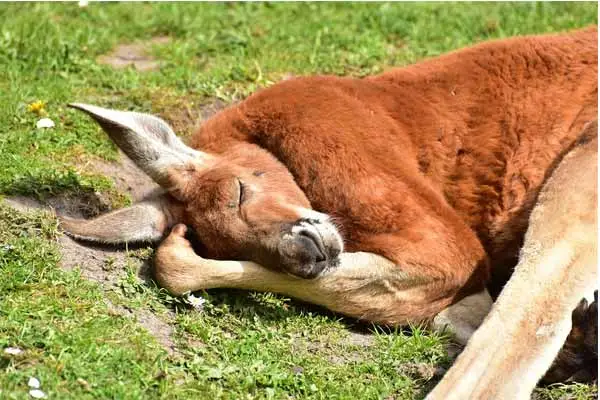
- Scientific Name: Osphranter rufus
- Size: 4.3-5.2 ft
- Weight: 40-200 lb
Kangaroos are famous for hopping and bouncing on their hind legs.
One species of kangaroo, red kangaroos are the biggest of all kangaroos, the biggest of all marsupials, and the biggest terrestrial mammal native to Australia.
They are easy to identify by long pointed ears and square muzzles.
Males have short red-brown color while the females are bluish-gray with a brown tinge.
Red kangaroos move by hopping using their back legs – they can jump 6 feet high and reach a top speed of 35 mph.
However, at birth, they are just 1 inch long and only weigh 0.035 oz!
They are commonly found in deserts and open grasslands of mainland Australia. Red kangaroos live in small groups of up to 4 animals and feed on green grass and plants.
Nankeen Night Heron

- Scientific Name: Nycticorax caledonicus
- Wingspan: 39 in
- Weight: 1.8-2.2 lb
Nankeen night herons are medium-sized herons.
They are also known as the rufous night herons because of their distinctive reddish-brown plumage.
These stocky birds have pale breasts, short necks, and large dark blue-black heads. The legs and feet are yellow.
Nankeen night herons are found close to rivers and streams where they feed on freshwater invertebrates, crayfish, sea turtle hatchlings, crabs, fish, frogs, lizards, and mice.
They are nocturnal birds that roost shortly after sundown and are most energetic from dusk to dawn.
Speckled Wood Butterfly
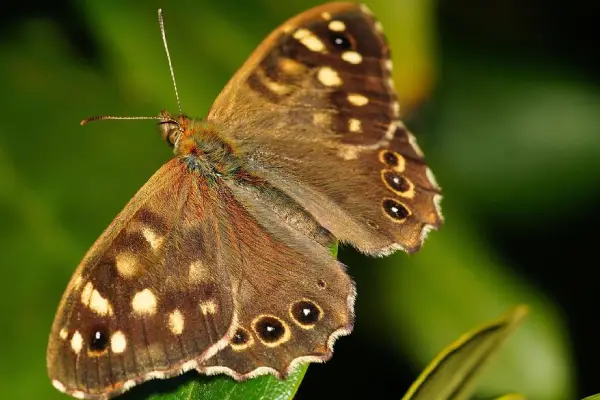
- Scientific Name: Pararge aegeria
- Wingspan: 2 in
Speckled woods are butterfly species found in the woodlands of Europe, Asia, and Africa.
There are 4 subspecies that can be differentiated by their color.
Speckled wood butterflies have chocolate-brown wings with creamy-yellow eye spots.
Males are slightly bigger than females but both have a wingspan of around 2 inches.
Speckled wood butterflies are diurnal and will feed on aphid honeydew.
Females are very picky when it comes to mating – they are monandrous and usually only mate once during their lifetime.
Males are polygynous and can mate several times – they are also very territorial and will fight with often fight with rivals until one loses.
Some cultures consider brown butterflies in the house a bad omen as they are thought to be messengers from the underworld.
Ruddy Duck

- Scientific Name: Oxyura jamaicensis
- Size: 13.5-17 in
- Weight: 1.2 lb
Ruddy ducks are small North American stiff-tailed birds found in the western and southern parts of the USA.
Identify them by their long stiff tails, short necks, and white heads and cheeks with black caps.
Male ruddy ducks have rich chestnut plumage and bright blue scoop-shaped bills during summer.
When the winter comes, they become gray-brown and their beaks become dull grayish-blue.
Females and immatures have brown plumage, dark caps, and a dark line through their pale cheeks.
Ruddy ducks breed in marshy lakes and ponds. Females will use grass to build the nests in tall vegetation and lay 5-15 whitish eggs. They have the largest eggs of all ducks, compared to their body size.
Ruddy ducks become very aggressive during the breeding season; they can be spotted chasing away rabbits feeding on the shore close to them!
When the winter comes, these migratory ducks move to coastal bays and unfrozen lakes and ponds.
Ruddy ducks are omnivorous and feed on insects, crustaceans, and aquatic plants; they will also dive to grab food.
As part of their courtship ritual, male ruddy ducks will also perform a “bubbling display” where they will beat their bills against their chests in a rapid fashion, forcing air bubbles from their feathers.
If you want to see more ducks similar to Ruddy ducks, check our photo guide on blue-billed ducks.
Bald Eagle

- Scientific Name: Haliaeetus leucocephalus
- Wingspan: 70.8-90.5 in
- Weight: 6.6-13.9 lb
Bald eagles are the national birds of the United States.
They have brown bodies, white heads and tails, and yellow legs and beaks.
Before attaining these characteristics around the age of five, bald eagles are mostly dark brown with varying amounts of white mottling.
Bald eagles are most common around coastal areas and inland areas near water.
According to the Florida Fish and Wildlife Conservation Commission, Florida has one of the densest concentrations of bald eagles in the US, with over 1,500 pairs found there.
They build one of the largest nests of any North American bird – the largest recorded one was in Florida and measured 10 feet wide and 20 feet deep.
These magnificent raptors are hard to miss as they soar through the air with their 7.5-foot-wide wingspan.
Bald eagles are carnivores and opportunistic feeders that primarily consume fish they snatch from the water with their sharp talons.
Rusty-tipped Page
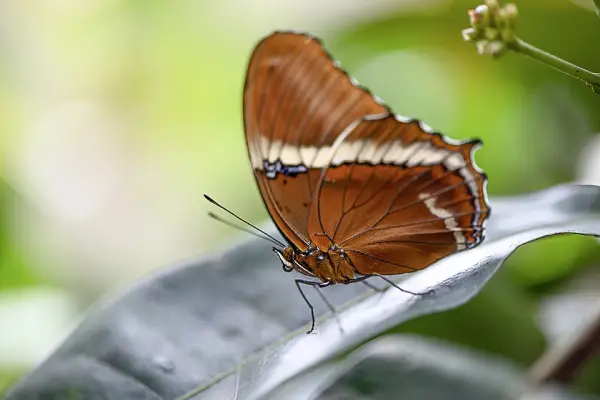
- Scientific Name: Siproeta epaphus
- Wingspan: 2-3 in
Rusty-tipped page, also known as brown siproeta, is a butterfly found in North, Central, and South America.
It inhabits tropical areas and there are 3 recognized subspecies.
Brown siproetas are dark brown butterflies with rust color on the tips of their forewings.
They feed on nectar from flowers like impatiens and lantana as well as juice from rotting fruit.
White-throated Kingfisher
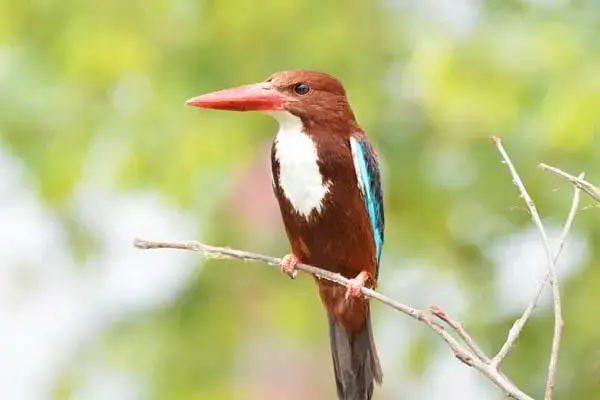
- Scientific Name: Halcyon smyrnensis
- Size: 10.6-11.0 in
- Weight: 2.6-3.9 oz
White-throated kingfishers are also known as white-breasted kingfishers.
These large brown birds also have bright blue wings, backs, and tails.
Recognize them by their large brown heads and thick heavy orange bills.
They inhabit wetlands, lakes, agricultural fields, and clearings in Asia, ranging from the Sinai east through the Indian subcontinent to the Philippines.
White-throated kingfishers are very aggressive towards their own kind as well as other kingfisher species.
They are carnivores that feed on fish, crabs and prawns, lizards, small snakes, insects, tadpoles, and earthworms.
Eastern Copperhead
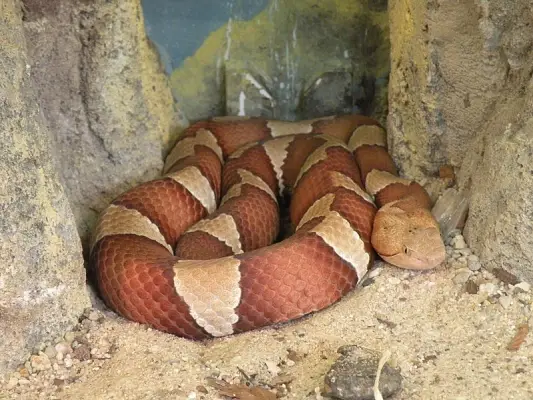
- Scientific Name: Agkistrodon contortrix
- Size: 20–37 in
- Weight: 3.5-12.1 oz
Eastern copperheads are dark brown snakes native to North America.
They are also known as copperheads and can be identified by the dark brown, hourglass-shaped markings that are overlaid on a light reddish brown background.
Copperheads are common in deciduous forests, mixed woodlands, and swamps of the eastern USA.
Their brown color helps them camouflage well in the surrounding – that’s why they freeze instead of slithering away.
These large snakes are responsible for more venomous snakebites than any other in the USA, due to their large populations. Luckily, their venom is relatively mild and the bites are rarely fatal.
Copperheads feed on rodents, small birds, lizards, and frogs – they bite their prey and pin them down until the venom does its job.
Red Panda
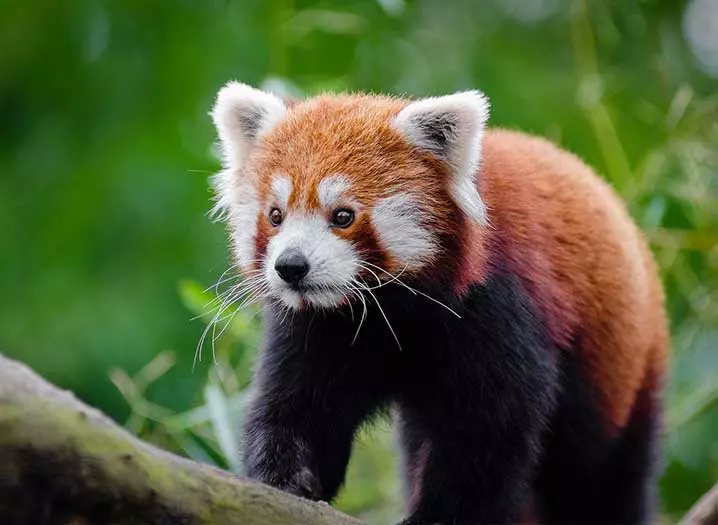
- Scientific Name: Ailurus fulgens
- Size: 22-25 in
- Weight: 8-17 lb
The red panda is a small mammal with thick reddish-brown fur, white-lined pointed ears, a white muzzle, and a ringed tail.
Despite the name, these furry and cute-looking animals are more closely related to raccoons than the black and white giant pandas.
Their babies are born with fur and look even more adorable than their adult counterparts. Red panda offspring will stay with their mothers for a year until they become fully grown.
Outside of the mating season, adult red pandas will live alone and rarely interact with others.
Mozilla’s browser, Firefox, the one you might be using right now, means “red panda”.
American Bison
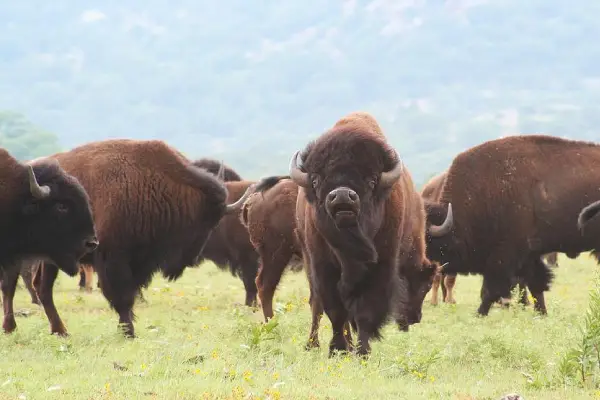
- Scientific Name: Bison bison
- Size: 9.3 ft (2.8 m)
- Weight: 701-2,599 lb
Native to North America, the American bison is one the heaviest animals in the USA.
It is a massive shaggy beast that is iconic in the Great Plains and the Old West.
American bison have characteristical humps over the front shoulders and slimmer hindquarters. Resting low on their short, stocky necks, the bulky head has a broad forehead and short, up-curving horns. The thick fur on the male’s forehead reduces the impact of the head clashing with other males.
Although superficially similar, the American and European bison are quite different.
They were once close to extinction with only around 325 remaining in 1884.
The only place in the US where American bison have continuously lived since prehistoric times is Yellowstone National Park.
Cinnamon Teal

- Scientific Name: Spatula cyanoptera
- Wingspan: 22 in
- Weight: 12-14 oz
Cinnamon teals are small dabbling ducks found in North and South America.
They breed in marshes and ponds of the western USA and some southwestern parts of Canada.
The species is migratory and they move to winter in Texas, California, Arizona, Mexico, the Caribbean, and northern parts of South America.
Identify male cinnamon teals by their cinnamon-brown plumage, brown backs, red eyes, and dark beaks.
Females have mottled brown plumage, pale brown heads, brown eyes, and gray beaks.
They are mostly found in pairs or small flocks, occasionally together with other species of ducks.
Cinnamon teals forage by dabbling and consume plants, insects, and mollusks.
Females will build their half-moon-shaped nests using stems and dead grass and lay 8-12 creamy white eggs.
A rather quiet species, male cinnamon teals will occasionally make low chattering calls while the females quack.
Read More: List of black and red animals
Summary
This concludes our list of brown animals.
Examples include several types of birds, butterflies, kangaroos, pangolins, herons, snakes, marmots, bears, etc.
Hopefully next time you see them, you will recognize any of them with ease!
And if you enjoyed our article, here are our other popular reads on animals: List of animals that resemble meerkats
We’ve also made a short web story with a few brown animals, view it here.